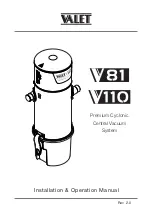
GB
- 18 -
point 5.2). The dirt bag (27) can be
fi
tted in additi-
on when removing particularly stubborn dirt (see
point 5.3).
Always ensure that the
fi
lters are perfectly secure.
6.3 Wet vacuuming
For wet-vacuuming, use the foam
fi
lter (25) (see
point 5.2).
Check that the
fi
lter is securely
fi
tted at all times.
Water drain screw (Fig. 1/11)
To make the tank (10) easier to empty after wet
vacuuming, it is
fi
tted with a water drain screw
(11).
Open the water drain screw (11) by turning it anti-
clockwise and drain the liquid.
When wet vacuuming, the
fl
oating safety switch
(Fig. 2/21) closes when the maximum tank level
is reached. In doing so, the suction noise of the
equipment will change and become louder.
You must then switch o
ff
the equipment and em-
pty the tank.
Danger!
The wet and dry vacuum cleaner is not suitable
for the vacuuming of combustible liquids.
For wet vacuuming, use only the supplied foam
fi
lter.
6.4 Automatic mode (Fig. 1)
Connect the power cable on your electric tool to
the automatic socket-outlet (4) and connect the
suction hose (9) to the extractor connector on
your electric tool. Check that the connections are
secure and air-tight.
You can use the supplied electric tool adaptor
(Fig. 3/22) to connect the suction hose (9) to the
electric tool. To do so,
fi
t it between the suction
hose and the extractor port on the electric tool.
Set the switch (7) on the wet and dry vacuum
cleaner to position AUTO, automatic mode. The
moment you switch on the electric tool, the wet
and dry vacuum cleaner switches on as well.
When you switch o
ff
the electric tool, the wet and
dry vacuum cleaner switches o
ff
as well after a
pre-set delay.
6.5 Blowing
Connect the suction hose (Fig. 1/9) to the blow
connector (Fig. 2/19) on the wet and dry vacuum
cleaner.
7. Replacing the power cable
Danger!
If the power cable for this equipment is damaged,
it must be replaced by the manufacturer or its
after-sales service or similarly trained personnel
to avoid danger.
8. Cleaning, maintenance and
ordering of spare parts
Danger!
Always pull out the mains power plug before star-
ting any cleaning work.
8.1 Cleaning
•
Keep all safety devices, air vents and the
motor housing free of dirt and dust as far as
possible.
•
We recommend that you clean the appliance
immediately after you use it.
8.2 Cleaning the appliance head (Fig. 1/5)
Clean the appliance regularly with a damp cloth
and some soft soap. Do not use cleaning agents
or solvents; these may be aggressive to the plas-
tic parts in the appliance.
8.3 Cleaning the container (Fig. 1/10)
The container can be cleaned with a damp cloth
and some soft soap or under running water, de-
pending on the amount of dirt.
8.4 Cleaning the
fi
lters
Cleaning the pleated
fi
lter (Fig. 3/24)
Clean the pleated
fi
lter (24) regularly by carefully
patting it and cleaning it with a
fi
ne brush or hand
brush.
Cleaning the foam
fi
lter (Fig. 3/25)
Clean the foam
fi
lter (25) with a little soft soap un-
der running water and allow it to air-dry.
Cleaning the
fi
lter (Figs. 19-20/1)
The
fi
lter (1) should be checked at regular inter-
vals and cleaned if necessary.
1. Remove
the
fi
lter cover (16) (Fig. 19)
2. Take out the
fi
lter (1) (Fig. 20)
3. Clean
the
fi
lter by tapping it or blowing it out
4. Assemble in reverse order
Anl_H_NT_30_Inox_SPK7.indb 18
Anl_H_NT_30_Inox_SPK7.indb 18
19.02.2018 14:47:09
19.02.2018 14:47:09
















































